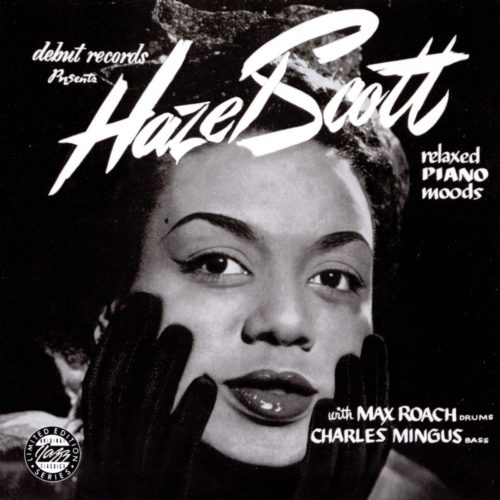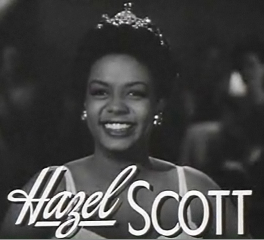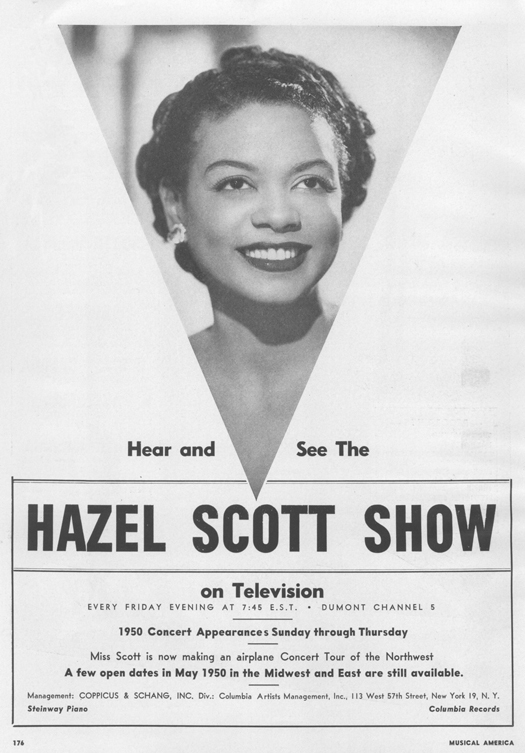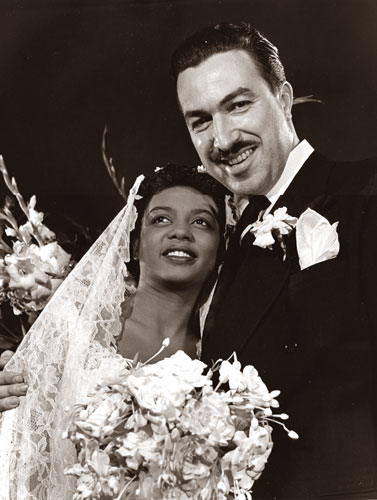Unsung Women of Jazz – Hazel Scott
I must admit, it did my jazzy little heart good to hear Alicia Keys give a shout out to Hazel Scott during her impressive dual piano stint on the 61st Grammy Awards. As soon as she sat down between the two keyboards, I thought of Ms. Scott and her scene in the 1943 film The Heat’s On which clearly was Ms. Keys’ inspiration.
“The Heat’s On” [Dual piano comes in the last 1:30]
 I’ve been an admirer of Ms. Scott’s for many years. Both for her piano prowess (though she usually only played one at a time) and for her willingness to take a stand for herself, as a black woman, even though it cost her considerably in her career, at a time when women would generally not do such a thing.
I’ve been an admirer of Ms. Scott’s for many years. Both for her piano prowess (though she usually only played one at a time) and for her willingness to take a stand for herself, as a black woman, even though it cost her considerably in her career, at a time when women would generally not do such a thing.
I first became aware of Hazel Scott, when as a teenager, I was causally watching the TV soap opera “One Life to Live”, with my mother, who was a huge fan. There was a wedding scene on the show between the two major black characters, Ed (played by the magnificent Al Freeman, Jr.) and Carla (Ellen Holly). Black love was very rare on television in that day, so it caught my eye. When this regal looking woman sat at the piano to play and sing, my mom says to our neighbor, who had stopped by to watch, “That’s Hazel Scott, ain’t it?” The neighbor watched closely for a few seconds and said “Yeah, that sure is. I haven’t seen her in a long time!”. I was struck by their excitement over this woman, so I asked. “Who’s Hazel Scott?”. My mom’s brief explanation (I was interrupting her “stories” – a cardinal sin), was that Hazel Scott was a singer, who used to be married to Adam Clayton Powell. I decided not to push it, lest I be banished.
I filed the info away, until I got to college a few years later and a real interest in jazz had taken hold. Here again, was the name Hazel Scott, accompanied by a striking album cover photo. The album was called Relaxed Piano Moods. She was leading a session, with Charles Mingus on bass and Max Roach on drums. By then, I knew Mingus and Roach pretty well. I figured if they were on this date, she must have something to say… Yes, she did. She was classically trained with a jazz style influenced by James P. Johnson’s stride and Ellington’s swing. The bop based backing of Mingus and Roach was a little new to her but she held her own. Relaxed Piano Moods is a good album.
So, who is Hazel Scott? She was born in Trinidad, in 1920. Her family moved to Harlem, when she was four. She was a piano prodigy, who was accepted to Julliard at age eight. By age fifteen she was opening for Count Basie and hosting her own radio show. By age eighteen, her classical and jazz hybrid piano style was packing them in at New York’s first integrated nightclub, Cafe Society.
By WWII, her talent, vivacious personality and beauty, had caught the attention of Hollywood. She was invited out West for screen tests and lit up the screen. But Ms. Hazel Scott knew her worth and her power. She was a civil rights activist from the beginning and the pianist/actress, by now in her early twenties, flatly refused any film role that she felt would cast her in a degrading light. She would not play a maid. She had riders in her film contracts, which gave her final approval, over her screen appearances and costumes. On the music circuit, her swinging classics, had made Hazel a national sensation, pulling in what would be in 2019, over $1,100,000 a year, for her club work alone.

In Hollywood, she was also quite popular. Her roles were never large, she usually was singing and playing piano but she was always gorgeous, dignified and elegant – a nascent feminist and an early model of black pride. In addition to The Heat’s On, with Mae West, she appeared in I Dood It, directed by Vicente Minelli; with Red Skelton; Rhapsody in Blue, with Robert Alda and Something to Shout About, with Don Ameche, among other films. Her Hollywood career came to an abrupt end, after a falling out with the all-powerful Columbia Pictures president, Harry Cohn, over a costume that she felt was stereotypical and demeaning. Cohn wanted black women, seeing their husbands off to war, to be dressed in dirty clothes with messy hair, while their white counterparts were dressed to the nines. Scott stood her ground, on behalf of herself and the rest of the black “war brides”. The production was shut down for three days. Ms. Scott won the battle, but Cohn vowed that she would not work again in Hollywood for the rest of his life. A vow that he kept.
 She was also a staunch anti-segregationist. At a time when black entertainers were expected to perform in clubs that would not welcome them as patrons, or if so, they were shunted off into separate parts of the venue, Hazel Scott would have no part of it. She would not perform in any club that did not have integrated seating. She told Time Magazine “Why would anyone come to hear me, a Negro and refuse to sit beside someone just like me?” She was literally escorted out of the city of Austin, TX, by Texas Rangers, for refusing to play in front of a segregated audience. She and her traveling companion, were refused service at a restaurant in Pasco, WA, in 1949, because of the color of their skin. Scott successfully sued the restaurant, which caused challenges to discrimination laws throughout the state and changes to Washington State laws within a few years.
She was also a staunch anti-segregationist. At a time when black entertainers were expected to perform in clubs that would not welcome them as patrons, or if so, they were shunted off into separate parts of the venue, Hazel Scott would have no part of it. She would not perform in any club that did not have integrated seating. She told Time Magazine “Why would anyone come to hear me, a Negro and refuse to sit beside someone just like me?” She was literally escorted out of the city of Austin, TX, by Texas Rangers, for refusing to play in front of a segregated audience. She and her traveling companion, were refused service at a restaurant in Pasco, WA, in 1949, because of the color of their skin. Scott successfully sued the restaurant, which caused challenges to discrimination laws throughout the state and changes to Washington State laws within a few years.
The year was 1950. The new medium of television was in its infancy. A lot of work in the early days was being done in New York. By now, Scott was married, to the legendary flamboyant minister and congressman, from Harlem, Adam Clayton Powell, Jr. She was also mother to a young son, Adam III. Staying close to home was a better option. The fledgling DuMont network offered Hazel her own show. When in premiered, in July 1950, The Hazel Scott Show, became the first network TV show, to be hosted by a black woman. Her show aired Monday, Wednesday and Friday, from 7:45 pm – 8 pm (they had 15 minute shows in those days). It was a musical program, that featured her and her guests performing various musical numbers. It received positive reviews and it looked like a hit that was set for a long run. However, the early days of television were hampered by a rampant “Red Scare”, in which artists were accused of being Communist Party members. Ms. Scott, was not then and never was a Communist. However, her no-nonsense manner and her controversial husband, along with her color, made her a prime target of the red baiters. Her name appeared in the rag, “Red Channels”. She voluntarily appeared before the House Un-American Activities Committee in mid-September 1950, and vehemently denied Communist Party membership. It didn’t matter. The sponsors ran for the hills and The Hazel Scott Show was cancelled on September 29, 1950.

By the late 50’s the Red Scare had affected Ms. Scott’s career. Her marriage to Powell, was also crumbling, due in large part to his philandering. To escape marital troubles, racism and political stupidity, Ms. Scott moved to Paris, in 1958. She then divorced Adam Clayton Powell in 1960 and married Swiss comedian Ezio Bedin, in 1961. They divorced amicably a few years later. By 1967, Scott, struggled to make a living in Europe, despite speaking seven languages. The passage of the Civil Rights Act, also meant that life had, legally, improved in the U.S. It was time for Hazel Scott, and her son, to go home.
Hazel Scott worked sporadically, over the last 15 years of her life, including the two episode OLTL gig, that I mentioned earlier. Sadly, she passed away from cancer, in October 1981. She was 61 years old.
If a simple shout out from Alicia Keys, will lead to a renaissance for this brilliant, overlooked, American artist and pioneer, I am all for it. Not too many of her recordings are currently in print but I will list a few below. There was also a definitive biography, written by Karen Chilton, in 2008.
Hazel Scott – Partial Discography
- Relaxed Piano Moods (with Mingus and Roach) [OJC]- her best album. Short in playing time but worthwhile. Get it while it’s still available.
- ‘Round Midnight [Fresh Sound] – An after hours style, easy listening album.
- Hazel Scott 1946-47 [Classics] – a nice overview of her style, combining short classical solos and swing jazz pieces. Recording quality is spotty. OOP and hard to find.
The Book
Hazel Scott: The Pioneering Journey of a Jazz Pianist, from Cafe Society to Hollywood to HUAC – by Karen Chilton; September 2008; University of Michigan Press
About the Author
Curtis Davenport
Curtis is a jazz historian, blogger and veteran radio personality. He currently produces the popular blog, CurtJazz.com and the web-based radio station, CurtJazz Radio.
Follow Curtis on his website, Curt's Jazz Cafe, CurtJazz Radio, Facebook and Twitter.
